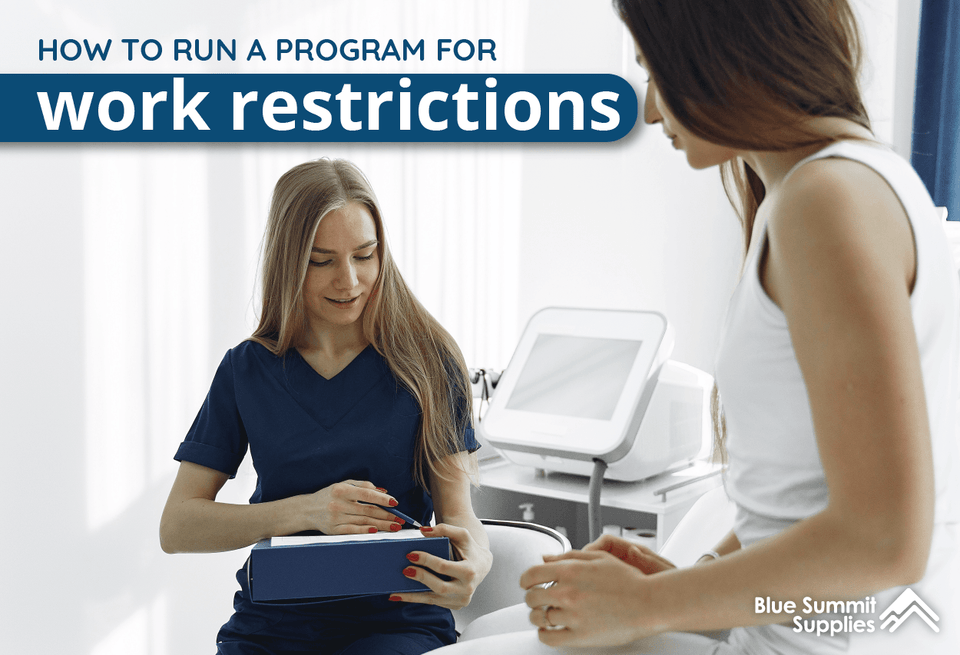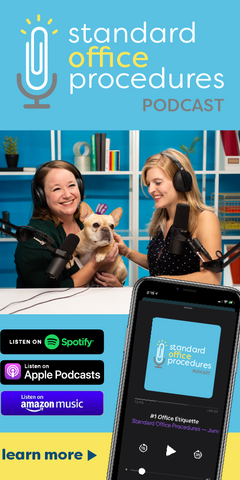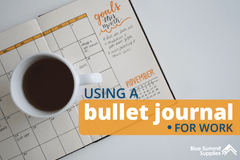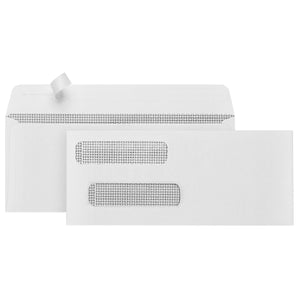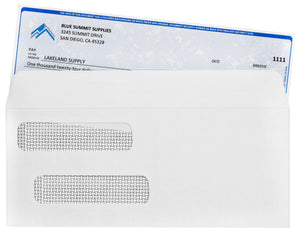When an employee experiences an illness or injury, whether inside or outside of the workplace, it can force them to take extended time off work. While recovery time is needed, the longer an employee is away from work completely, the worse it is for them, their team, and the workplace. Work restrictions, sometimes called modified duty, light-duty, transitional work, or early return-to-work programs, bring employees back into the workplace safely and gradually. A work restrictions letter from doctors or nurse practitioners (NP) provides businesses with critical medical information and recommendations for returning an employee safely back to work.
This post will discuss why it’s so important to get employees back to work, the types of restrictions an employee could need, and how to set up a work restrictions program that can get injured team members back to work safely and gradually. We’ve included a release to work letter from doctor example as well as a downloadable sample return to work letter from doctor to employer that employees can print for their doctor to fill out.
Return to Work Letter From Doctor: What it is and Why it’s Needed
While time off work is sometimes needed to recover after an occupational or non-occupational injury or illness, too much time off work can be detrimental to the employee and the workplace.
As an injury heals, it’s important that the rest of the body stay active to avoid further injury. Too much sitting or a sedentary lifestyle poses a number of negative health effects, and muscle mass begins to decrease even after a few days of inactivity. When an athlete is injured, they begin rehabilitation and reconditioning as soon as possible to ensure the rest of the body maintains its strength.
Plus, the longer an employee is away from work, the less likely they are to return. They can fall behind, aspects of their role may be slowly taken on by other people, they may not feel like they fit in, or they may begin to forget how to complete work tasks.
Returning employees back to work quickly and safely provides the best opportunity for gradual rehabilitation. A physician return to work letter is used in these circumstances to provide the appropriate information to employers or managers so that they can make the required changes at work.

A return to work letter from doctor to employer provides critical information about what restrictions the employee needs in order to return back to work. Ideally, these forms should include details about the illness or injury, what restrictions are required, and an initial assessment of how long these restrictions are required. Restrictions could be reduced hours, limited duties, or modified equipment.

Return to Work Letter From Doctor Example
To whom it may concern,
[Employee Name] is suffering from a wrist injury that will prevent them from fulfilling all of their workplace duties. It is my hope that they can return in a limited capacity as this injury heals.
They will not be able to perform any strenuous activities, such as carrying boxes or lifting equipment. Typing tasks and computer work is possible but should be limited. I have recommended cushioned wrist pads that the employee will bring into the workplace. I also recommend they reduce their hours to avoid strain and to make time for their physiotherapy appointments, which will occur twice a week.
Thank you for making the necessary adjustments to allow [Employee Name] to return back to work in a limited capacity for the next six weeks.
[Doctor Name]
[Doctor Signature]
[Date Signed]
Types of Work Restrictions to Consider

Reduced Hours
Depending on the reason for an employee being off of work, reduced hours may help them return sooner. Accommodating shorter working days can help injured or sick employees get back to work in shorter doses that can gradually increase. This will help ensure work isn’t too strenuous and give them more time to recover while still keeping them involved in the business.

Shorter Workweek
A shorter workweek can also give employees additional time to gradually recover. This keeps employees involved in the business and up-to-date on practices while not putting too much stress on the person trying to recover. Fewer days working also means the employee can dedicate part of their week specifically to recovery, such as attending therapy appointments, physio sessions, or other doctor recommended recovery plans.

Restricted Duties
Work restrictions might include limiting certain duties that the recovering employee is not able to perform anymore. For example, someone suffering from a shoulder injury may not be able to pick up inventory boxes in the office. As an employer or manager, consider an employee's limitations and adjust duties as needed to ensure recovery continues, and no further injuries or ailments occur. Duties could be limited only during the recovery phase or, depending on the injury or disability, the employee may not be able to perform certain functions permanently.

Modified Equipment, Tools, or Workspaces
Business tools or equipment may need to be altered to help an employee return to work. Investing in equipment that keeps employees safe and healthy in the workplace benefits everyone, as workplace injuries are far more expensive than equipment. These could be small fixes, such as investing in cushioned wrist resting pads for someone dealing with a wrist injury or larger office changes like switching to standing desks or utilizing a break room as a space for regular movement and stretching.
How to Run a Program For Work Restrictions: Letter From Doctor Requirements, Policies, and Best Practices

Understand the Americans with Disabilities Act (ADA)
Employers and managers should be aware of the Americans with Disabilities Act (ADA), which protects people with disabilities. The act prohibits discrimination against individuals with disabilities and ensures they are reasonably accommodated in the workplace.
The Employment section of the act is:
“...designed to help people with disabilities access the same employment opportunities and benefits available to people without disabilities. Employers must provide reasonable accommodations to qualified applicants or employees. A reasonable accommodation is any modification or adjustment to a job or the work environment that will enable an applicant or employee with a disability to participate in the application process or to perform essential job functions.”
Following this act helps establish an inclusive and diverse workplace, and understanding its ins and outs also prevents businesses from getting into trouble with the law.
📚 Discrimination at Work: Signs You Need a Workplace Discrimination Attorney.

Inform Your Team and New Hires of Your Work Restrictions Program
Make sure everyone you employ is aware of your work restriction program and inform new hires of your policies. A program like this is an appealing perk that can help attract talent and keep current hires on your payroll. You never know when an injury or illness could occur, but having the peace of mind that your workplace will support you is reassuring.
Put your policies in writing, clearly stating what your program entails. Work restriction programs often include a time frame of up to six weeks where an employee can reduce hours, limit duties, or implement other restrictions that can help them transition back to work should they incur an occupational or non-occupational injury or illness.

Doctor Letter to Return to Work Policy
Requiring a return back to work letter from doctors or NPs ensures an employer is properly informed about any workplace restrictions that are required for an employee to return to work safely. It’s not just about supplying a workplace with proof—the letter also sufficiently prepares the business for the necessary changes that need to be made, whether that’s reduced hours, restricted duties, or additional equipment.
Establish a policy for return to work doctor’s notes. Does your business require a doctor's note? What situations require a doctor’s note? Can a nurse practitioner fill out the doctor’s note, or does it need to come from a doctor directly? What should be included? Who does the doctor's note need to go to within the business? How will you maintain employee confidentiality?
Set clear policies to avoid confusion within the workplace. The more questions you answer upfront, the fewer you’ll have to answer later on, and when practices are in writing, it saves from having to answer the same questions over and over again.

Doctor Return to Work Letter Download
Providing employees with a clear form they can take to their doctor should the worst occur will same them time while dealing with an already stressful situation. The form will also ensure you receive the information you need about the employee's illness or injury so that you can best accommodate their return.
Download our free Return to Work Letter From Doctor Template:
 |
Click here to download our free return to work letter! |
More from Blue Summit Supplies
💡 What to Consider For a Return to Office Plan
💡 Time Off Request Forms For Sick Leave, Vacation, and More
Our office supplies blog is filled with resources for business owners, managers, admins, and professionals. Follow us for the latest career advice, industry trends, office strategies, and downloadable tools.
If you have any questions or want to talk to someone about office supplies, send us an email or connect with us on Twitter, Facebook, or Instagram.
 For more informative articles about office supplies, subscribe to our email newsletter!
For more informative articles about office supplies, subscribe to our email newsletter!
Never fear, you won't begin receiving daily sales emails that belong in a spam folder. Instead, we promise a fun weekly roundup of our latest blog posts and great finds from across the web. And if you lose interest, it's always easy to unsubscribe with a single click.

